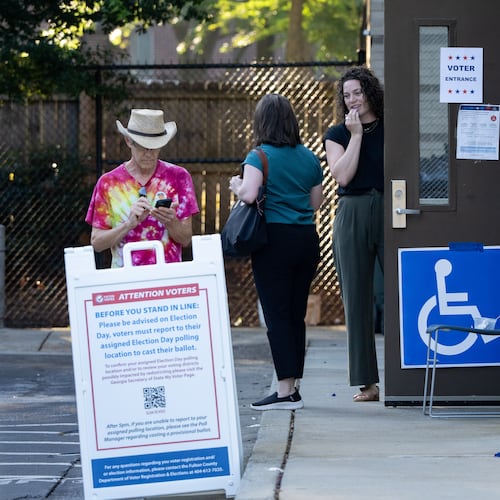While Georgia’s unemployment numbers surged at the beginning of the coronavirus pandemic, the number of people who received welfare continued to drop from 2019 through June.
Those experiencing financial hardship may have chosen instead to turn to help from food stamps, where the number of households receiving the benefit has shot up by nearly 250,000 in a year.
State officials and advocates say there could be a number of reasons for the decrease in the Temporary Assistance for Needy Families program, commonly known as welfare. The decline of nearly 800 households follows a decades-long trend of fewer and fewer people receiving the public benefits.
The criteria to qualify for TANF are more strict than what is needed to qualify for food stamps, Division of Family and Children Services Director Tom Rawlings said. DFCS administers the state’s food stamp and welfare programs.
“A lot of folks who might be potential TANF applicants are receiving either expanded unemployment or unemployment benefits,” Rawlings said. “You have to exhaust your unemployment benefits before you can qualify for TANF.”
In July 2019, TANF benefits were granted to 9,165 Georgia households, according to DFCS data provided to The Atlanta Journal-Constitution. By June 2020, that number was down to 8,346.
Many out-of-work Georgians qualified for $600 per week in unemployment benefits approved by the federal government in April, in addition to any state benefits offered. The expanded program expired at the beginning of this month.
In a recent executive order, President Donald Trump proposed an extension of the expanded unemployment program that aims to provide weekly payments of $400. But Georgia’s labor officials said they are awaiting guidance from the federal government before telling the state’s unemployed what to expect. Some critics questioned whether Trump has the authority to implement the order.
If the benefits are paid, they could disqualify those seeking assistance through TANF. But if and when that additional federal money runs out, Rawlings said he expects to see an increase in people seeking welfare.
To be eligible for welfare in Georgia, a family of three must have a gross income below $784 a month. That same family could have a monthly gross income of up to $2,311 and still qualify for Supplemental Nutrition Assistance Program benefits, commonly known as food stamps.
Alex Camardelle, a senior policy analyst with the left-leaning Georgia Budget and Policy Institute, said the continued decline could have also been caused by the state not making the application process available online until the beginning of June. Previously, applicants would have to go into a state office to apply for welfare or call to request and return a paper application through the mail. And, due to the pandemic, most, if not all, state offices were closed.
“That went on for the first two months of the crisis,” Camardelle said. “But we have to acknowledge that TANF in the state of Georgia, by its design, discourages participation, generally. It’s not promoted as a strong support for families in need. It’s not promoted at all widely throughout the state of Georgia.”
But SNAP, Camardelle said, is typically viewed as the “first line of defense for families whenever they fall on hard times.”
According to DFCS data, there were about 605,000 households receiving almost $161 million in SNAP benefits in July 2019. By this past June, nearly 848,000 households were receiving more than $301 million in benefits.
The average monthly benefit also increased by nearly $100 per household in that time, due to the state increasing the amounts recipients could receive to the maximum allowed based on their household size because of the pandemic.
And plans were abandoned to implement statewide work requirements for people the state has identified as able-bodied adults without dependents by April. The work requirements led to about 600,000 fewer people receiving food stamps in 2019 than in 2013. Rawlings said they will not be enforced again until, at the earliest, July 2021.
Kyle Waide, the president and CEO at the Atlanta Community Food Bank, said he’s seen more people turning to food pantries for help during the pandemic.
“What the increase in participation in SNAP reveals in particular is that the program is working as it’s intended,” he said. “When the economy softens and when the job market deteriorates, it results in more families struggling. That’s exactly whats happening here.”
This summer, people have sought 50% more food from his organization’s pantries than last year.
“I think when someone loses their job or loses hours at work or experiences some other form of financial crisis, it means they now have to make really difficult choices in how they use the resources they have left. They make trade-off decisions,” he said. “Do I buy food or do I pay rent? Getting help with rent is often a lot more challenging, or help with utilities, than getting help with food.
“If SNAP weren’t there, God knows what kind of crisis we’d be facing,” Waide said.
It’s difficult to know how long the economy will continue to struggle. About 1.3 million Georgians have applied for unemployment since March, but the Georgia Department of Labor last month said the number of residents who were out of work was declining.
Georgia’s unemployment rate dropped to 7.6% in June from 9.4% in May amid continued rehiring in many sectors that had largely shut down in early spring. As the economy recovers, Waide said he expects those who’ve been hit with severe financial distress to recover more slowly.
“A lot of families are really hurting right now,” Waide said. “The more we can help them stay solid during this time of adversity, the quicker we recover as a community.”
About the Author
Keep Reading
The Latest
Featured




